10-1 The Moon’s airless, dry surface is covered with plains and craters
Compared with the distances between planets, which are measured in tens or hundreds of millions of kilometers, the average distance from Earth to the Moon is just 384,400 km (238,900 mi). Despite being so close, the Moon has an angular diameter of just ½°, which tells us that it is a rather small world. The diameter of the Moon is 3476 km (2160 mi), just 27% of Earth’s diameter and about the same as the distance from Las Vegas to Philadelphia or from London to Cairo (Figure 10-1). Table 10-1 lists some basic data about the Moon.
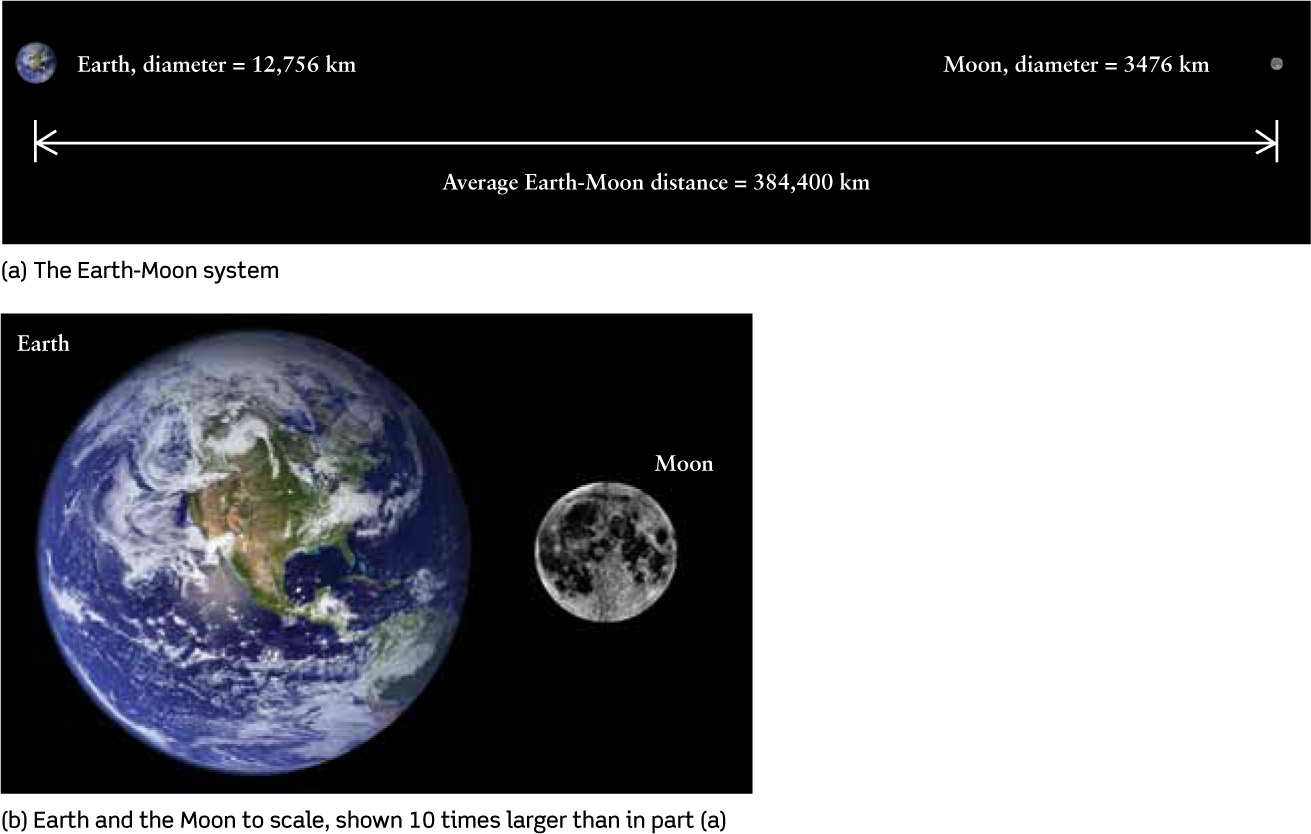
Comparing Earth and the Moon (a) The Moon is a bit more than one-quarter the diameter of Earth. The average Earth-Moon distance is about 30 times Earth’s diameter. (b) Earth has blue oceans, an atmosphere streaked with white clouds, and continents continually being reshaped by plate tectonics. By contrast, the Moon has no oceans, no atmosphere, and no evidence of plate tectonics.
TABLE 10-1 MOON DATA

Motions of the Earth-Moon System
 Although the Moon has a small mass (just 1.23% of Earth’s mass), Newton’s third law tells us that the Moon exerts just as much gravitational force on Earth as Earth does on the Moon (see Section 4-6). Hence, it is not strictly correct to say that the Moon orbits Earth; rather, they both orbit around a point between their centers called the center of mass of the Earth-Moon system. (Because Earth is so much more massive than the Moon, the center of mass is close to Earth’s center: Indeed, it actually lies within Earth’s interior.) The center of mass then follows an elliptical orbit around the Sun (Figure 10-2a). In a similar way, a spinning wrench sliding along a table actually rotates around its center of mass (Figure 10-2b).
Although the Moon has a small mass (just 1.23% of Earth’s mass), Newton’s third law tells us that the Moon exerts just as much gravitational force on Earth as Earth does on the Moon (see Section 4-6). Hence, it is not strictly correct to say that the Moon orbits Earth; rather, they both orbit around a point between their centers called the center of mass of the Earth-Moon system. (Because Earth is so much more massive than the Moon, the center of mass is close to Earth’s center: Indeed, it actually lies within Earth’s interior.) The center of mass then follows an elliptical orbit around the Sun (Figure 10-2a). In a similar way, a spinning wrench sliding along a table actually rotates around its center of mass (Figure 10-2b).
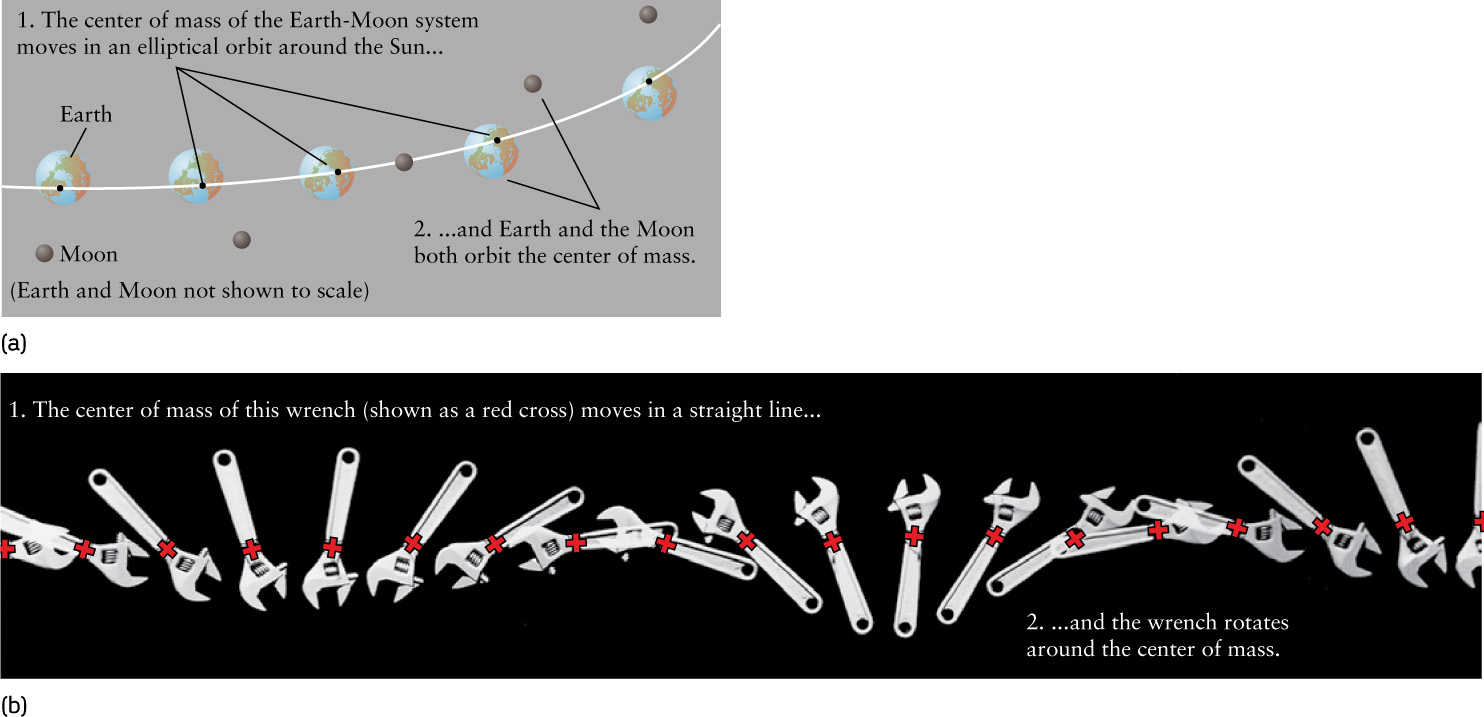
Motion of the Earth-Moon System (a) Earth and the Moon both orbit around their center of mass, which in turn follows an elliptical orbit around the Sun. (b) The illustration in part (a) is analogous to this time-lapse image of a spinning wrench sliding across a table.
The Moon’s Rotation and Libration
Even without binoculars or a telescope, you can easily see that dark gray and light gray areas cover vast expanses of the Moon’s rocky surface. If you observe the Moon over many nights, you will see the Moon go through its phases as the dividing line between the illuminated and darkened portion of the Moon (the terminator) shifts. But you will always see the same pattern of dark and light areas, because the Moon keeps the same side turned toward Earth; you never see the far side (or back side) of the Moon. We saw in Section 3-2 that this is the result of the Moon’s synchronous rotation: It takes precisely the same amount of time for the Moon to rotate on its axis (one lunar “day”) as it does to complete one orbit around Earth.
 With patience, however, you can see slightly more than half the lunar surface, because the Moon appears to wobble slightly over the course of an orbit. It seems to rock back and forth around its north-south axis and to nod up and down in a north-south direction. This apparent periodic wobbling, called libration, permits us to view 59% of our satellite’s surface.
With patience, however, you can see slightly more than half the lunar surface, because the Moon appears to wobble slightly over the course of an orbit. It seems to rock back and forth around its north-south axis and to nod up and down in a north-south direction. This apparent periodic wobbling, called libration, permits us to view 59% of our satellite’s surface.
 We stress that the Moon only appears to be wobbling. In fact, its rotation axis keeps nearly the same orientation in space as the Moon goes around its orbit. The reason why the Moon seems to rock back and forth is that its orbit around Earth is slightly elliptical. As a result, the Moon’s orbital motion does not keep pace with its rotation at all points around the orbit. Furthermore, because the Moon’s rotation axis is not exactly perpendicular to the plane of its orbit, it appears to us to nod up and down.
We stress that the Moon only appears to be wobbling. In fact, its rotation axis keeps nearly the same orientation in space as the Moon goes around its orbit. The reason why the Moon seems to rock back and forth is that its orbit around Earth is slightly elliptical. As a result, the Moon’s orbital motion does not keep pace with its rotation at all points around the orbit. Furthermore, because the Moon’s rotation axis is not exactly perpendicular to the plane of its orbit, it appears to us to nod up and down.
257
258
An Airless World
Clouds always cover some portion of Earth’s surface. However, clouds are never seen on the Moon (see Figure 10-1), because the Moon is too small a world to have an atmosphere. Its surface gravity is low, only about one-sixth as great as that of Earth, and thus any gas molecules can easily escape into space (see Box 7-2). Because there is no atmosphere to scatter sunlight, the daytime sky on the Moon appears as black as the nighttime sky on Earth (see the photograph that opens this chapter).
The absence of an atmosphere means that the Moon can have no liquid water on its surface. Here on Earth, water molecules are kept in the liquid state by the pressure of the atmosphere pushing down on them. To see what happens to liquid water on the airless Moon, consider what happens when the pressure of the atmosphere is reduced. The air pressure in Denver, Colorado (elevation 1650 m, or 5400 ft), is only 83% as great as at sea level. Therefore, in Denver, less energy has to be added to the molecules in a pot of water to make them evaporate, and water boils at only 95°C (= 368 K = 203°F), as compared with 100°C (= 373 K = 212°F) at sea level. (This temperature dependence on pressure is why some foods require longer cooking times at high elevations, where the boiling water used for cooking is not as hot as at sea level.) On the Moon, the atmospheric pressure is essentially zero, and the boiling temperature is lower than the temperature of the lunar surface. Under these conditions, water can exist as a solid (ice) or a vapor but not as a liquid.
CAUTION!
If astronauts were to venture out onto the lunar surface without wearing spacesuits, the lack of atmosphere would not cause their blood to boil. That’s because our skin is strong enough to contain bodily fluids. In the same way, if we place an orange in a sealed container and remove all the air, the orange retains all of its fluid and does not explode. It even tastes the same afterward! The reasons why astronauts wore pressurized spacesuits on the Moon (see the photograph that opens this chapter) were to provide oxygen for breathing, to regulate body temperature, and to protect against ultraviolet radiation from the Sun. Since the Moon has no atmosphere, and thus no ozone layer like that of Earth to screen out ultraviolet wavelengths (Section 9-7), an unprotected astronaut would suffer a sunburn after just 10 seconds of exposure!
Lunar Craters
 Since the Moon has no atmosphere to obscure its surface, you can get a clear view of several different types of lunar features with a small telescope or binoculars. These include craters, the dark-colored maria, and the light-colored lunar highlands or terrae (Figure 10-3). Taken together, these different features show the striking differences between the surfaces of Earth and the Moon.
Since the Moon has no atmosphere to obscure its surface, you can get a clear view of several different types of lunar features with a small telescope or binoculars. These include craters, the dark-colored maria, and the light-colored lunar highlands or terrae (Figure 10-3). Taken together, these different features show the striking differences between the surfaces of Earth and the Moon.
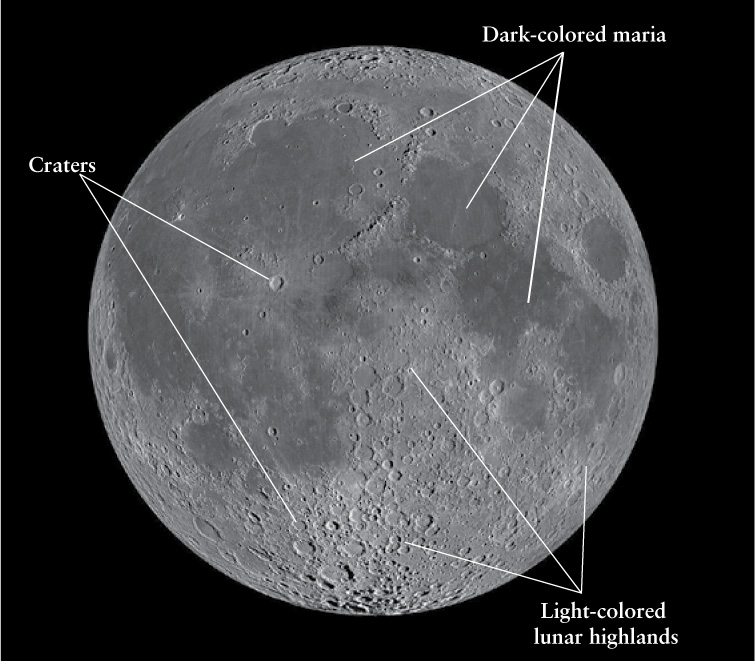
The Near Side of the Moon The key features of the lunar surface can be seen with binoculars, a small telescope, or even the naked eye. This composite image was made with more than 1300 images from the Lunar Reconnaissance Orbiter.
With an Earth-based telescope, some 30,000 craters are visible, with diameters ranging from 1 km to several hundred km. Close-up photographs from lunar orbit have revealed millions of craters too small to be seen from Earth. Following a tradition established in the seventeenth century, the most prominent craters are named after famous philosophers, mathematicians, and scientists, such as Plato, Aristotle, Pythagoras, Copernicus, and Kepler. Virtually all lunar craters, both large and small, are the result of the Moon’s having been bombarded by meteoroids and asteroids. (Meteoroids are just the smaller range of these space rocks.) For this reason, they are also called impact craters (see Section 7-6). High-speed impacts have been recreated in laboratories to study what happens for different impacting materials and different angles of impact. Based on experiments, two key pieces of evidence for the impact-origin of lunar craters are the central peak found in some craters (see Figure 7-10a), and that different angles of impact still produce circular craters.
An asteroid striking the lunar surface generates a shock wave over the surface outward from the point of impact. Such shock waves can spread over an area much larger than the size of the asteroid that generated the wave. Very large craters more than 100 km across, such as the crater Clavius shown in Figure 10-4, were probably created by the impact of a fast-moving piece of rock only a few kilometers in radius.

The Crater Clavius This crater is one of the largest on the Moon. Clavius has a diameter of 232 km (144 mi) and a depth of 4.9 km (16,000 ft), measured from the crater’s floor to the top of the surrounding rim. Later impacts formed the smaller craters inside Clavius.
Maria: Dark and Relatively Young
The large dark areas on the lunar surface shown in Figure 10-3 are called maria (pronounced “MAR-ee-uh”). They form a pattern that looks crudely like a human face, sometimes called “the man in the Moon.” The singular form of maria is mare (pronounced “MAR-ay”), which means “sea” in Latin. These terms date from the seventeenth century, when observers using early telescopes thought these dark features were large bodies of water. They gave the maria fanciful and romantic names such as Mare Tranquillitatis (Sea of Tranquility), Mare Nubium (Sea of Clouds), Mare Nectaris (Sea of Nectar), Mare Serenitatis (Sea of Serenity), and Mare Imbrium (Sea of Showers). While modern astronomers still use these names, they now understand that the maria are not bodies of water (which, as we have seen, could not exist on the airless Moon) but rather the remains of huge lava flows. The maria get their distinctive appearance from the dark color of the solidified lava.
259
On the whole, the maria have far fewer craters than the surrounding terrain. Craters are caused by meteoritic bombardment, so the maria have not been exposed to that bombardment for as long as the surrounding terrain. Hence, the maria must be relatively young, and the lava flows that formed them must have occurred at a later stage in the Moon’s geologic history (Figure 10-5). The craters that are found in the maria were caused by the relatively few impacts that have occurred since the maria solidified (Figure 10-6).

Mare Imbrium from Earth Mare Imbrium is the largest of 14 dark plains that dominate the Earth-facing side of the Moon. Its diameter of 1100 km (700 mi) is about the same as the distance from Chicago to Philadelphia or from London to Rome. The maria formed after the surrounding light-colored terrain, so they have not been exposed to meteoritic bombardment for as long and hence have fewer craters.
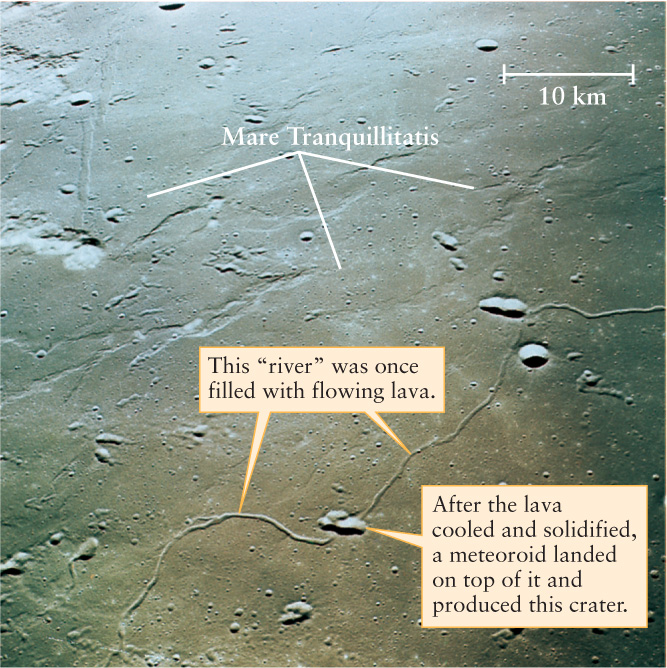
Details of Mare Tranquillitatis This color photograph from lunar orbit reveals numerous tiny craters in the surface of a typical mare. The curving “river,” or rille, was carved out by flowing lava that later solidified; similar features are found in volcanic areas on Earth. The Apollo 11 landing site is near the center of the top edge of this image.
Although they are much larger than craters, maria also tend to be circular in shape (see Figure 10-5). This suggests that, like craters, these depressions in the lunar surface were also created by large impacts. It is thought that very large asteroids some tens of kilometers across struck the Moon, forming basins. These depressions subsequently flooded with lava that flowed out from the Moon’s interior through cracks in the lunar crust. The solidified lava formed the maria that we see today. However, the large basin-creating impacts probably did not directly cause the lava flows because the lava is typically dated to about 500 million years after the impacts. The Cosmic Connections figure depicts our understanding of how lunar craters and maria formed.
An impact large enough to create a mare basin must have thrust upward tremendous amounts of material around the impact site. This explains the mountain ranges that curve in circular arcs around mare basins. Analysis of lunar rocks as well as observations made from lunar orbit have validated this picture of the origin of lunar mountains.
260
COSMIC CONNECTIONS
The Formation of Craters and Maria on the Moon
The physical features of lunar craters and maria show that they were formed by asteroids impacting the Moon’s surface at high speed. The crater labeled in the photograph, called Aristillus after a Greek astronomer who lived around 300 b.c.e., is 55 km (34 miles) across and 3600 m (12,000 ft) deep.
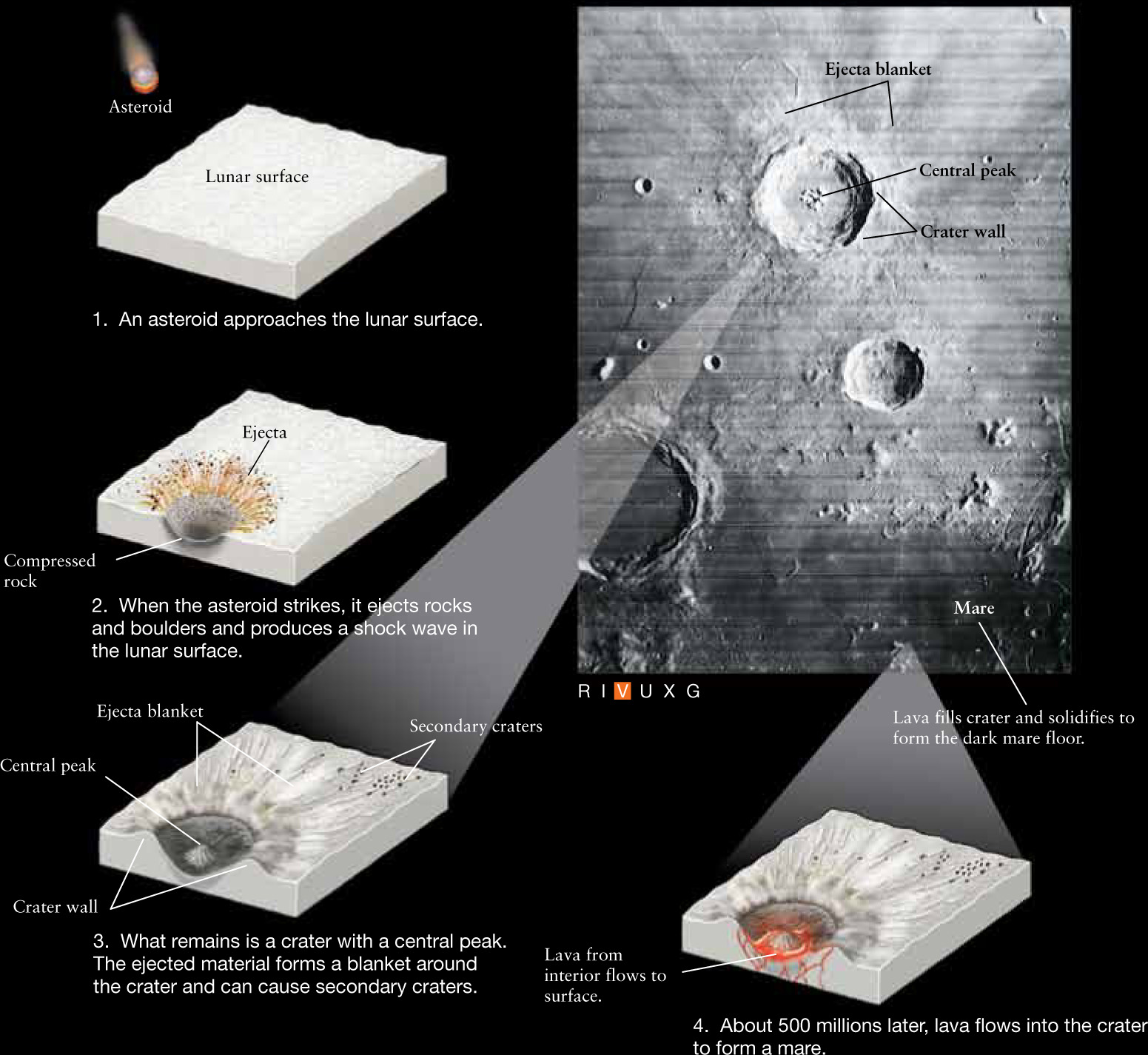
261
Lunar Highlands: Light-Colored and Ancient
The light-colored terrain that surrounds the maria is called terrae, from the Latin for “lands.” (Seventeenth-century astronomers thought that this terrain was the dry land that surrounded lunar oceans.) Detailed measurements by astronauts in lunar orbit demonstrated that the maria on the Moon’s Earth-facing side are 2 to 5 km below the average lunar elevation, while the terrae extend to several kilometers above the average elevation. For this reason terrae are often called lunar highlands (see Figure 10-3). The flat, low-lying, dark gray maria cover only 15% of the lunar surface; the remaining 85% is light gray lunar highlands. Since the lunar highlands are more heavily cratered than the maria, we can conclude that the highlands are older.
Remarkably, when the Moon’s far side was photographed for the first time by the Soviet Luna 3 spacecraft in 1959, scientists were surprised to find almost no maria there. Lunar highlands predominate on the side of the Moon that faces away from Earth (Figure 10-7). Presumably, the crust is thicker on the far side, so even the most massive impacts there were unable to crack through the crust and let lava flood onto the surface. The Moon is not unique in having major portions with different crustal thicknesses: Earth’s northern hemisphere has much more continental crust than its southern hemisphere, and the southern hemisphere of Mars has a thicker crust than the northern hemisphere.

 The Near and Far Sides of the Moon The iron-rich darker maria are a younger surface made from ancient lava flows and are 2 to 5 km below the average surface elevation. The cratered highlands are an older surface several kilometers above the average elevation. The South Pole—Aitken Basin reaches depths of 12 km, but was never filled in by darker lava flows. These images were made by the Lunar Reconnaissance Orbiter.
The Near and Far Sides of the Moon The iron-rich darker maria are a younger surface made from ancient lava flows and are 2 to 5 km below the average surface elevation. The cratered highlands are an older surface several kilometers above the average elevation. The South Pole—Aitken Basin reaches depths of 12 km, but was never filled in by darker lava flows. These images were made by the Lunar Reconnaissance Orbiter.
Although the Moon’s far side has fewer maria than the near side, the highlands on the far side are as heavily pockmarked by impacts as those on the near side. The most prominent feature on the far side is the South Pole—Aitken Basin, the largest known impact crater in the solar system. This basin is about 2500 km (1600 mi) across—about the same size as the continent of Europe. The Aitken Basin isn’t as dark as the maria because very little lava has filled in the basin, which also leaves it with an extraordinary depth of 12 km.
A World Without Plate Tectonics
Something is entirely missing from our description of the Moon’s surface—any mention of plate tectonics. Indeed, no evidence for plate tectonics can be found on the Moon. Recall from Section 9-3 that Earth’s major mountain ranges were created by collisions between lithospheric plates. In contrast, it appears that the Moon is a one-plate world: Its entire lithosphere is a single, solid plate. There are no rifts where plates are moving apart, no mountain ranges of the sort formed by collisions between plates, and no subduction zones. Thus, while lunar mountain ranges bear the names of terrestrial ranges, such as the Alps, Carpathians, and Apennines, they are entirely different in character. They were formed by material ejected from impact sites, not by plate tectonics. Geologically, the Moon is a nearly dead world. In Section 7-6 we discussed the general rule that a world with abundant craters has an old, geologically inactive surface. The Moon is a prime example of this rule. Without an atmosphere to cause erosion and without plate tectonics, the surface of the Moon changes only very slowly. That is why the Moon’s craters, many of which are now known to be billions of years old, remain visible today. On Earth, by contrast, the continents and seafloor are continually being reshaped by seafloor spreading, mountain building, and subduction. Thus, any craters that were formed by impacts on the ancient Earth’s surface have long since been erased. Fewer than 200 impact craters are known to exist on Earth today; these were formed within the last few hundred million years and have not yet been erased.
In contrast to Earth and its active geology, the Moon’s surface is geologically dead
262
In 2010, evidence for some surprisingly recent geological activity on the Moon was found. The Moon has long cliffs called scarps that develop as the entire Moon cools and shrinks (Figure 10-8). A good analogy for the formation of these scarps is the wrinkling seen on a fruit’s skin as the fruit dries out and contracts. It had been thought that the Moon cooled quickly after formation, and that all scarps were billions of years old. However, the craters disturbed by a scarp can indicate the scarp’s age and suggest some of these geologic features might be as young as a few hundred million years old. The Moon has probably shrunk about 600 feet in diameter since it first formed, and this new evidence suggests that it might still be shrinking today.
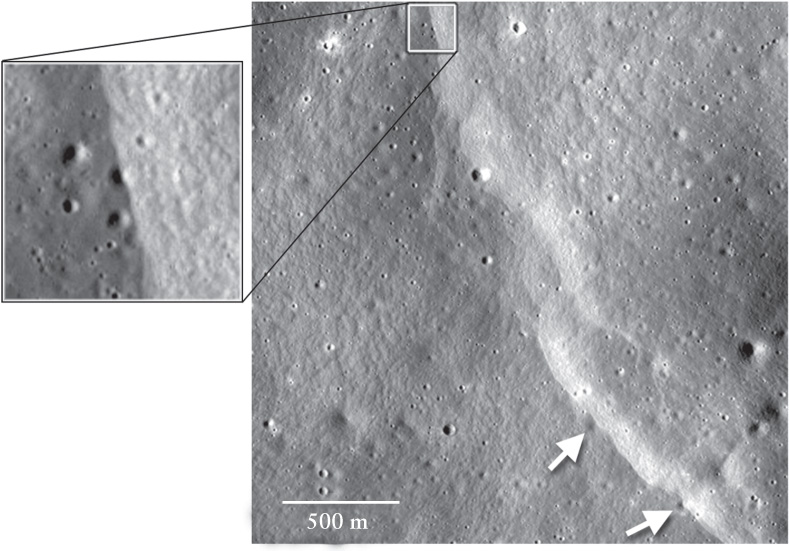
Recent Geologic Activity of Scarps This image shows a long cliff called a scarp—formed as the Moon cools, shrinks, and wrinkles—that is cutting across several small craters (see the inset, and the two arrows). Until discovery in 2010, it was thought these scarps were billions of years old. But small craters allow for a unique way to estimate ages. Small craters (less than about 400 meters) typically do not last very long on the lunar surface because they are disturbed by ongoing micrometeorite impacts. Furthermore, when an image shows that a scarp cuts across a crater, it means the scarp is even younger than the crater. By analyzing scarps and their underlying craters, some scarps are thought to be less than a billion years old, and could be as young as a hundred million years old.
CONCEPT CHECK 10-1
Why does darker rock appear at lower elevations?